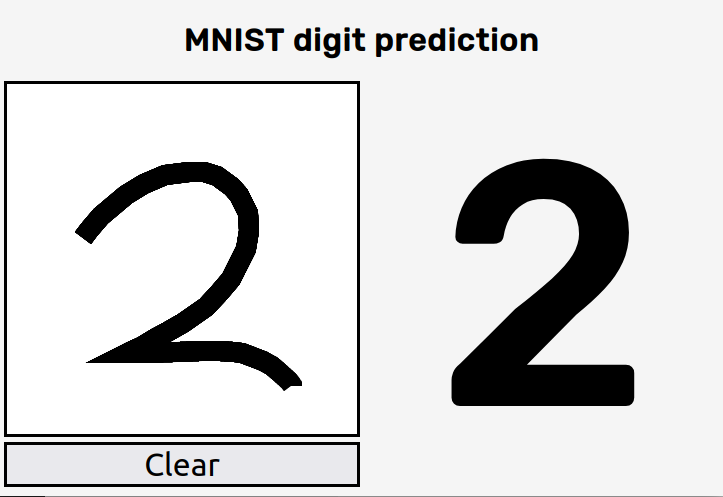This is the solution of Exercise 9 of Chapter 5 of the book Hands-On Machine Learning with Scikit-Learn, Keras & Tensorflow.
It classifies digits between 0 and 9. It is trained using the MNIST dataset from OpenML.
It also provides a simple web interface for testing the predictions, which can be run with the following command (make sure to install the dependencies and generate the model before):
$ flask run --host=0.0.0.0
and looks like this.
Create a virtual environment, activate it and install the dependencies with
$ python3 -m venv venv
$ source ./venv/bin/activate
$ pip install -r requirements.txt
To generate and train the model use the following commands:
$ python -m fetch
$ python -m train -k rbf
You can use the following models from the CLI:
$ python -m fetch -h
usage: fetch.py [-h] [-o OUTPATH] [-s] [-r]
Fetch the mnist_784 dataset from openml, and save it to HDF5.
optional arguments:
-h, --help show this help message and exit
-o OUTPATH, --outpath OUTPATH
The filepath where the HDF5 dataset will be saved.
-s, --shift Augment the dataset by shifting the images.
-r, --rotate Augment the dataset by rotating the images.
$ python -m train -h
usage: train.py [-h] [-g] [-d DATASET] [-o OUTPATH] [-v] [-m] [-C REGULARIZATION] [-G GAMMA] [-k KERNEL]
Train a model from an HDF5 dataset and export it to a file.
optional arguments:
-h, --help show this help message and exit
-g, --gridsearch Perform a grid search for optimizing the hyperparameters. If specified the model hyperparameters (e.g. --gamma and
--regularization) are ignored.
-d DATASET, --dataset DATASET
A filepath containing the dataset in the HDF5 format.
-o OUTPATH, --outpath OUTPATH
The filepath for storing the trained model.
-v, ---verbose Display information about the trained model on stdout.
-m, --metrics Display metrics computed on the test set.
-C REGULARIZATION, --regularization REGULARIZATION
Regularization parameter. The strength of the regularization
is inversely proportional to C. Must be strictly
positive. The penalty is a squared l2 penalty
-G GAMMA, --gamma GAMMA
Kernel coefficient for 'rbf', 'poly' and 'sigmoid'. Can be a
float value or one of 'scale' and 'auto'
-k KERNEL, --kernel KERNEL
The SVM kernel to be used. The following values are allowed:
rbf, sigmoid, poly.
$ python -m predict -h
usage: predict.py [-h] [-m MODEL] [-v] [images [images ...]]
Predict an image of a digit between 0 and 9 using an SVM classificator.
positional arguments:
images The filepath of the image to be predicted.
optional arguments:
-h, --help show this help message and exit
-m MODEL, --model MODEL
The filepath of the trained model.
-v, ---verbose Display information about the trained model on stdout.
The following kernels are supported: rbf, polynomial, sigmoid. Of those the most promising is the rbf kernel.
I perform a grid search on the validation set, train the model with the best parameters on the training set, and then evaluate the accuracy on the test set. With that I get the following results.
$ python3 -m train -k rbf -v -m -g
INFO Loading dataset from data.h5INFO Performing grid search.
Fitting 5 folds for each of 8 candidates, totalling 40 fits
INFO Search time: 736.29s
INFO Search Accuracy: 0.9444000000000001
INFO Best parameters: {
"clf__C": 8,
"clf__gamma": "scale",
"clf__kernel": "rbf"
}
INFO Training an SVM classifier with rbf kernel
INFO Training time: 260.68s
INFO Metrics computed on the test set
precision recall f1-score support
0 0.98 0.99 0.99 980
1 0.99 0.99 0.99 1135
2 0.93 0.98 0.95 1032
3 0.97 0.98 0.97 1010
4 0.97 0.97 0.97 982
5 0.97 0.96 0.97 892
6 0.98 0.98 0.98 958
7 0.97 0.96 0.97 1028
8 0.97 0.96 0.97 974
9 0.98 0.95 0.96 1009
accuracy 0.97 10000
macro avg 0.97 0.97 0.97 10000
weighted avg 0.97 0.97 0.97 10000
Confusion matrix:
[[ 968 0 3 2 1 2 3 0 1 0]
[ 0 1126 3 0 0 1 3 1 1 0]
[ 6 3 1007 1 2 0 1 4 7 1]
[ 0 0 7 987 1 5 0 4 6 0]
[ 0 0 13 0 951 2 3 4 1 8]
[ 2 0 9 9 1 859 5 1 4 2]
[ 5 2 3 1 3 6 936 0 2 0]
[ 0 6 17 2 6 1 0 987 0 9]
[ 3 0 10 6 6 8 1 4 932 4]
[ 1 3 7 8 11 2 0 12 3 962]]
Even though this looks quite good, the predictions on the web interface are not as good as this. I guess that's in part, because the SVM model is not accurate enough and in part because the training data are not well suited for this application. The MNIST dataset consists of handwritten digits, while we make predictions on digits drawn on a HTML canvas. These are different things.
